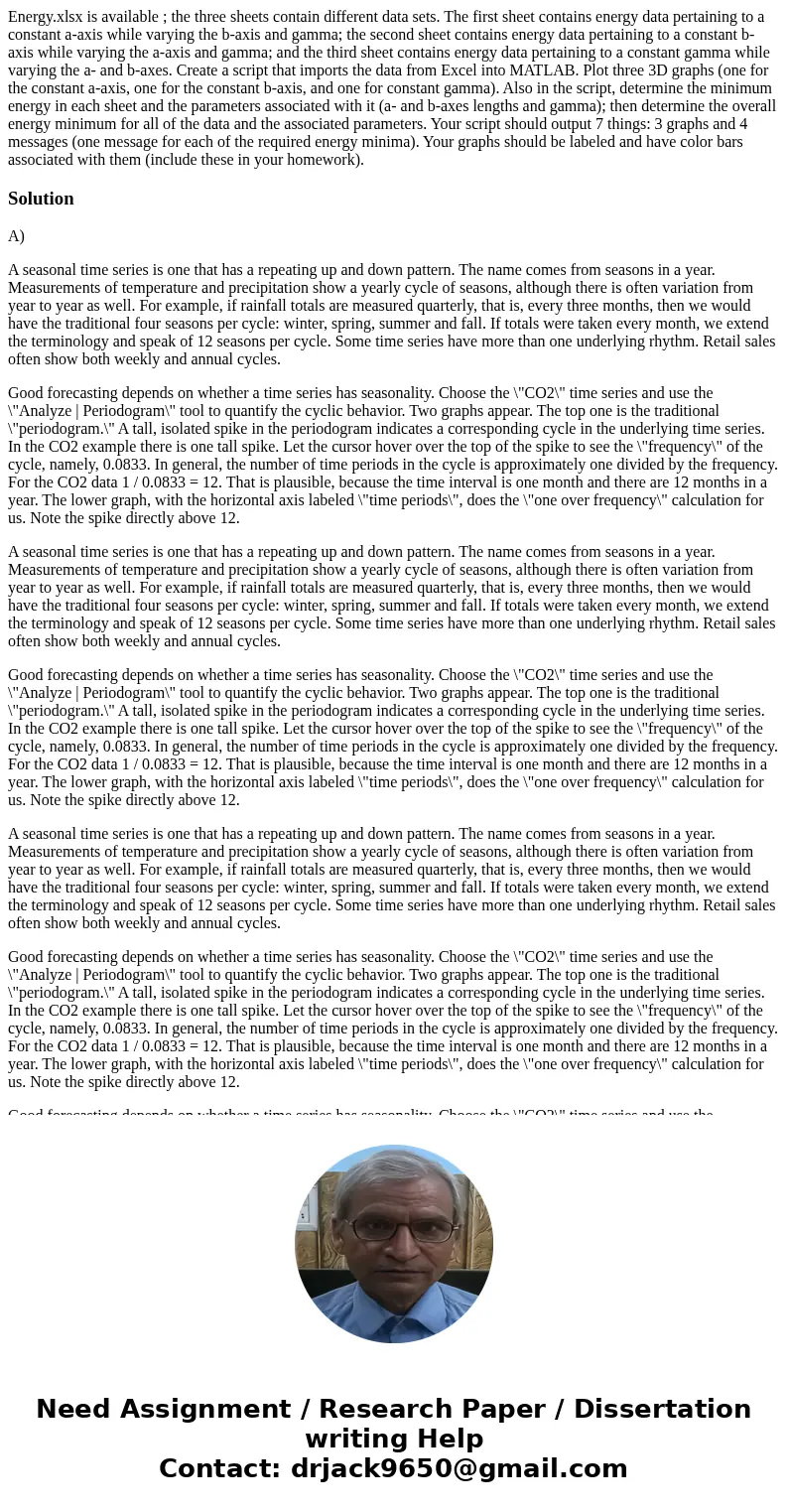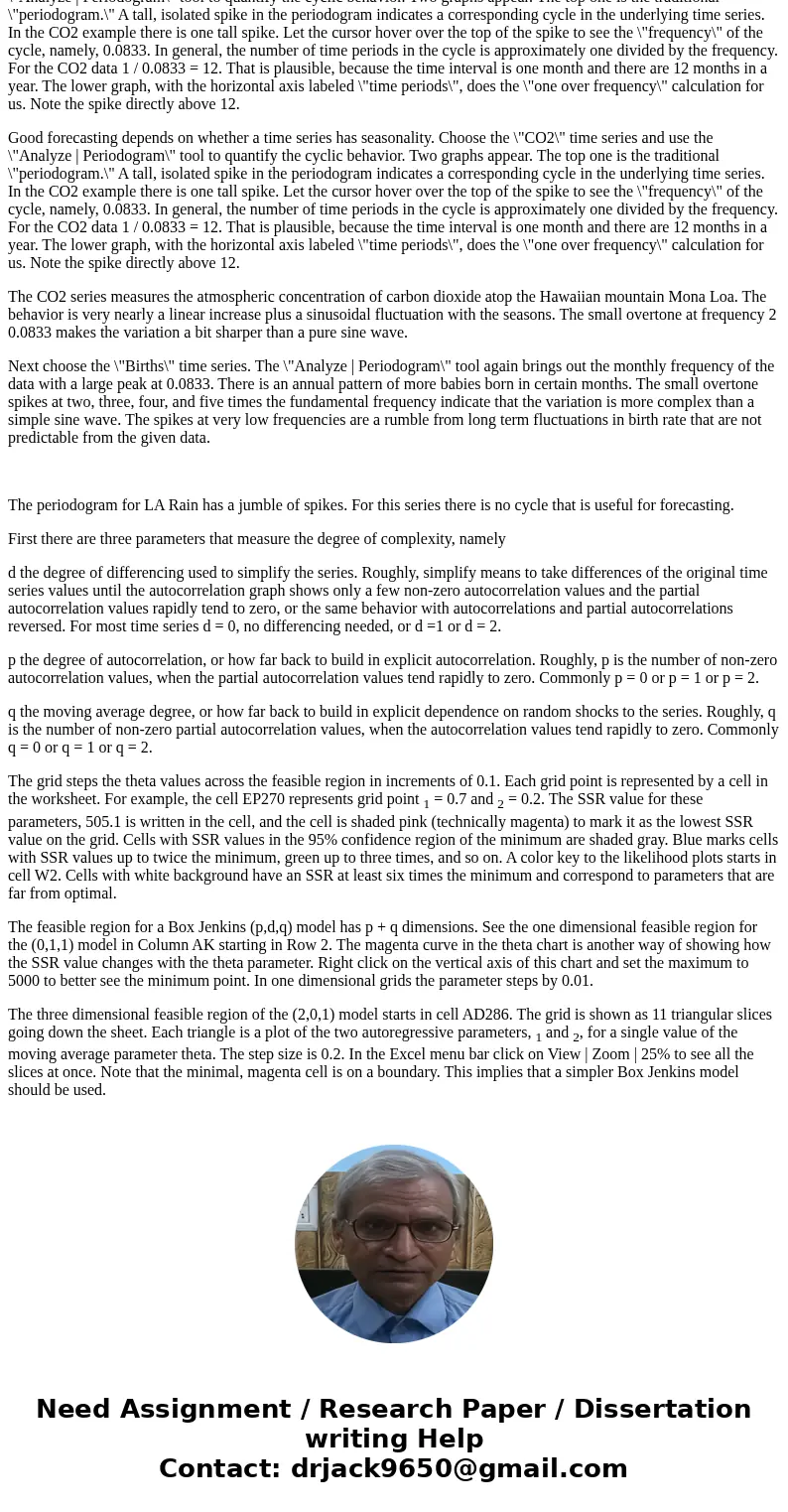Energyxlsx is available the three sheets contain different
Energy.xlsx is available ; the three sheets contain different data sets. The first sheet contains energy data pertaining to a constant a-axis while varying the b-axis and gamma; the second sheet contains energy data pertaining to a constant b-axis while varying the a-axis and gamma; and the third sheet contains energy data pertaining to a constant gamma while varying the a- and b-axes. Create a script that imports the data from Excel into MATLAB. Plot three 3D graphs (one for the constant a-axis, one for the constant b-axis, and one for constant gamma). Also in the script, determine the minimum energy in each sheet and the parameters associated with it (a- and b-axes lengths and gamma); then determine the overall energy minimum for all of the data and the associated parameters. Your script should output 7 things: 3 graphs and 4 messages (one message for each of the required energy minima). Your graphs should be labeled and have color bars associated with them (include these in your homework).
Solution
A)
A seasonal time series is one that has a repeating up and down pattern. The name comes from seasons in a year. Measurements of temperature and precipitation show a yearly cycle of seasons, although there is often variation from year to year as well. For example, if rainfall totals are measured quarterly, that is, every three months, then we would have the traditional four seasons per cycle: winter, spring, summer and fall. If totals were taken every month, we extend the terminology and speak of 12 seasons per cycle. Some time series have more than one underlying rhythm. Retail sales often show both weekly and annual cycles.
Good forecasting depends on whether a time series has seasonality. Choose the \"CO2\" time series and use the \"Analyze | Periodogram\" tool to quantify the cyclic behavior. Two graphs appear. The top one is the traditional \"periodogram.\" A tall, isolated spike in the periodogram indicates a corresponding cycle in the underlying time series. In the CO2 example there is one tall spike. Let the cursor hover over the top of the spike to see the \"frequency\" of the cycle, namely, 0.0833. In general, the number of time periods in the cycle is approximately one divided by the frequency. For the CO2 data 1 / 0.0833 = 12. That is plausible, because the time interval is one month and there are 12 months in a year. The lower graph, with the horizontal axis labeled \"time periods\", does the \"one over frequency\" calculation for us. Note the spike directly above 12.
A seasonal time series is one that has a repeating up and down pattern. The name comes from seasons in a year. Measurements of temperature and precipitation show a yearly cycle of seasons, although there is often variation from year to year as well. For example, if rainfall totals are measured quarterly, that is, every three months, then we would have the traditional four seasons per cycle: winter, spring, summer and fall. If totals were taken every month, we extend the terminology and speak of 12 seasons per cycle. Some time series have more than one underlying rhythm. Retail sales often show both weekly and annual cycles.
Good forecasting depends on whether a time series has seasonality. Choose the \"CO2\" time series and use the \"Analyze | Periodogram\" tool to quantify the cyclic behavior. Two graphs appear. The top one is the traditional \"periodogram.\" A tall, isolated spike in the periodogram indicates a corresponding cycle in the underlying time series. In the CO2 example there is one tall spike. Let the cursor hover over the top of the spike to see the \"frequency\" of the cycle, namely, 0.0833. In general, the number of time periods in the cycle is approximately one divided by the frequency. For the CO2 data 1 / 0.0833 = 12. That is plausible, because the time interval is one month and there are 12 months in a year. The lower graph, with the horizontal axis labeled \"time periods\", does the \"one over frequency\" calculation for us. Note the spike directly above 12.
A seasonal time series is one that has a repeating up and down pattern. The name comes from seasons in a year. Measurements of temperature and precipitation show a yearly cycle of seasons, although there is often variation from year to year as well. For example, if rainfall totals are measured quarterly, that is, every three months, then we would have the traditional four seasons per cycle: winter, spring, summer and fall. If totals were taken every month, we extend the terminology and speak of 12 seasons per cycle. Some time series have more than one underlying rhythm. Retail sales often show both weekly and annual cycles.
Good forecasting depends on whether a time series has seasonality. Choose the \"CO2\" time series and use the \"Analyze | Periodogram\" tool to quantify the cyclic behavior. Two graphs appear. The top one is the traditional \"periodogram.\" A tall, isolated spike in the periodogram indicates a corresponding cycle in the underlying time series. In the CO2 example there is one tall spike. Let the cursor hover over the top of the spike to see the \"frequency\" of the cycle, namely, 0.0833. In general, the number of time periods in the cycle is approximately one divided by the frequency. For the CO2 data 1 / 0.0833 = 12. That is plausible, because the time interval is one month and there are 12 months in a year. The lower graph, with the horizontal axis labeled \"time periods\", does the \"one over frequency\" calculation for us. Note the spike directly above 12.
Good forecasting depends on whether a time series has seasonality. Choose the \"CO2\" time series and use the \"Analyze | Periodogram\" tool to quantify the cyclic behavior. Two graphs appear. The top one is the traditional \"periodogram.\" A tall, isolated spike in the periodogram indicates a corresponding cycle in the underlying time series. In the CO2 example there is one tall spike. Let the cursor hover over the top of the spike to see the \"frequency\" of the cycle, namely, 0.0833. In general, the number of time periods in the cycle is approximately one divided by the frequency. For the CO2 data 1 / 0.0833 = 12. That is plausible, because the time interval is one month and there are 12 months in a year. The lower graph, with the horizontal axis labeled \"time periods\", does the \"one over frequency\" calculation for us. Note the spike directly above 12.
The CO2 series measures the atmospheric concentration of carbon dioxide atop the Hawaiian mountain Mona Loa. The behavior is very nearly a linear increase plus a sinusoidal fluctuation with the seasons. The small overtone at frequency 2 0.0833 makes the variation a bit sharper than a pure sine wave.
Next choose the \"Births\" time series. The \"Analyze | Periodogram\" tool again brings out the monthly frequency of the data with a large peak at 0.0833. There is an annual pattern of more babies born in certain months. The small overtone spikes at two, three, four, and five times the fundamental frequency indicate that the variation is more complex than a simple sine wave. The spikes at very low frequencies are a rumble from long term fluctuations in birth rate that are not predictable from the given data.
The periodogram for LA Rain has a jumble of spikes. For this series there is no cycle that is useful for forecasting.
First there are three parameters that measure the degree of complexity, namely
d the degree of differencing used to simplify the series. Roughly, simplify means to take differences of the original time series values until the autocorrelation graph shows only a few non-zero autocorrelation values and the partial autocorrelation values rapidly tend to zero, or the same behavior with autocorrelations and partial autocorrelations reversed. For most time series d = 0, no differencing needed, or d =1 or d = 2.
p the degree of autocorrelation, or how far back to build in explicit autocorrelation. Roughly, p is the number of non-zero autocorrelation values, when the partial autocorrelation values tend rapidly to zero. Commonly p = 0 or p = 1 or p = 2.
q the moving average degree, or how far back to build in explicit dependence on random shocks to the series. Roughly, q is the number of non-zero partial autocorrelation values, when the autocorrelation values tend rapidly to zero. Commonly q = 0 or q = 1 or q = 2.
The grid steps the theta values across the feasible region in increments of 0.1. Each grid point is represented by a cell in the worksheet. For example, the cell EP270 represents grid point 1 = 0.7 and 2 = 0.2. The SSR value for these parameters, 505.1 is written in the cell, and the cell is shaded pink (technically magenta) to mark it as the lowest SSR value on the grid. Cells with SSR values in the 95% confidence region of the minimum are shaded gray. Blue marks cells with SSR values up to twice the minimum, green up to three times, and so on. A color key to the likelihood plots starts in cell W2. Cells with white background have an SSR at least six times the minimum and correspond to parameters that are far from optimal.
The feasible region for a Box Jenkins (p,d,q) model has p + q dimensions. See the one dimensional feasible region for the (0,1,1) model in Column AK starting in Row 2. The magenta curve in the theta chart is another way of showing how the SSR value changes with the theta parameter. Right click on the vertical axis of this chart and set the maximum to 5000 to better see the minimum point. In one dimensional grids the parameter steps by 0.01.
The three dimensional feasible region of the (2,0,1) model starts in cell AD286. The grid is shown as 11 triangular slices going down the sheet. Each triangle is a plot of the two autoregressive parameters, 1 and 2, for a single value of the moving average parameter theta. The step size is 0.2. In the Excel menu bar click on View | Zoom | 25% to see all the slices at once. Note that the minimal, magenta cell is on a boundary. This implies that a simpler Box Jenkins model should be used.


 Homework Sourse
Homework Sourse